Abstract
The polymerase chain reaction (PCR) technique has been adapted to identify the sex of preimplantation mouse embryos rapidly. PCR was used to amplify a specific repeated DNA sequence on the Y chromosome from a single isolated blastomere in under 12 hr. The remainder of the biopsied embryo was then transferred to a pseudopregnant female and carried to term. Using this technique, 72% of embryos can be classed as potentially either male or female. Transfers of such embryos have produced pregnancies with 8/8 fetuses (100%) being of the predicted sex. Variations of the technique have demonstrated certain limitations to the present procedure as well as indicated possible strategies for improvement of the assay. The PCR technique may have wide application in the genetic analysis of preimplantation embryos.
Full text
PDF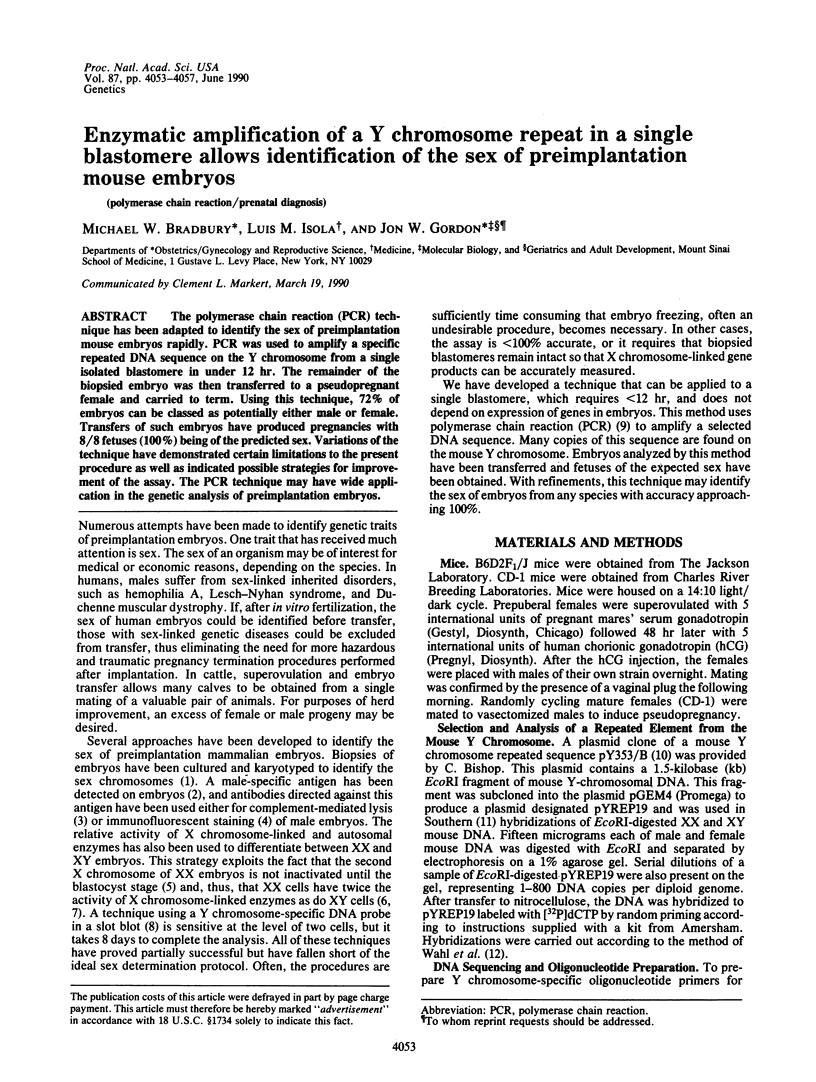
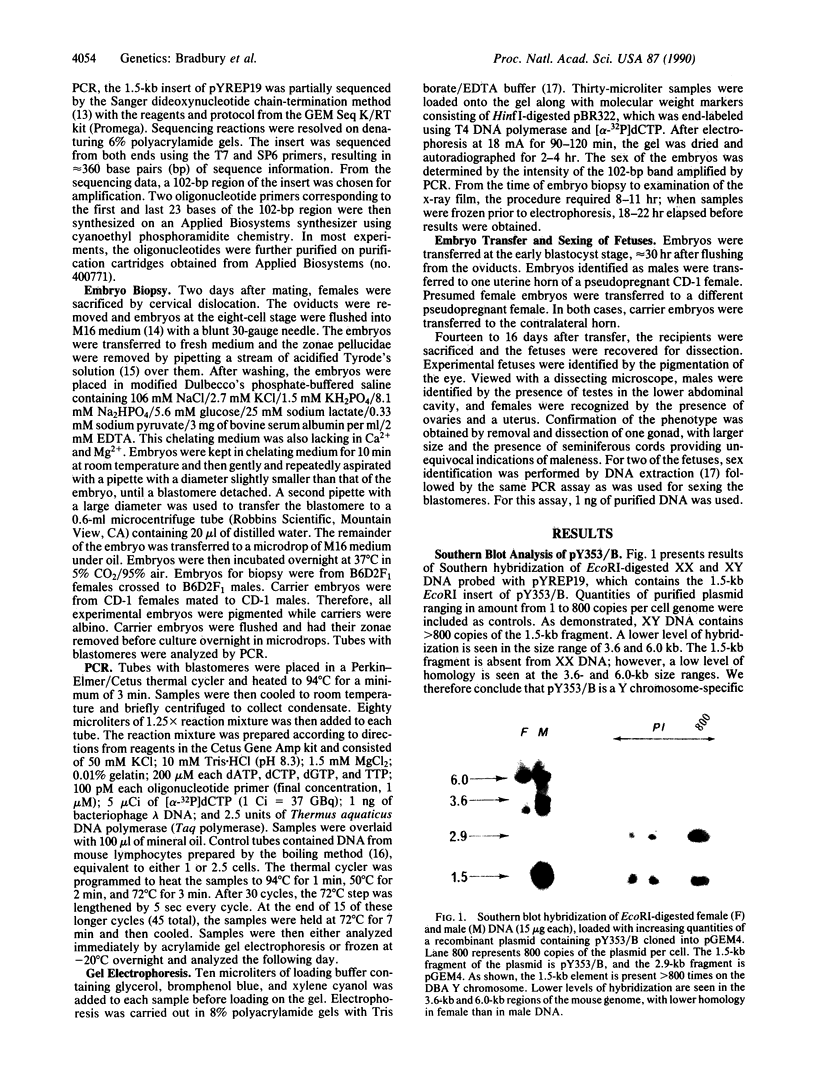
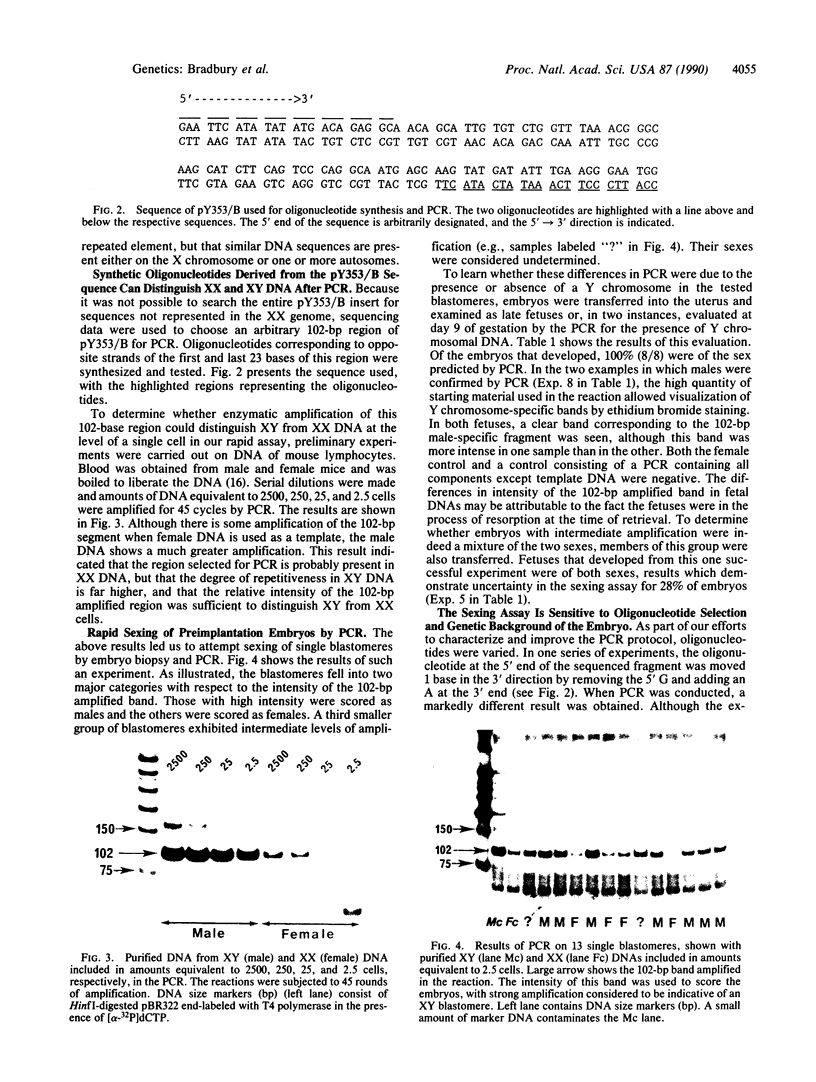
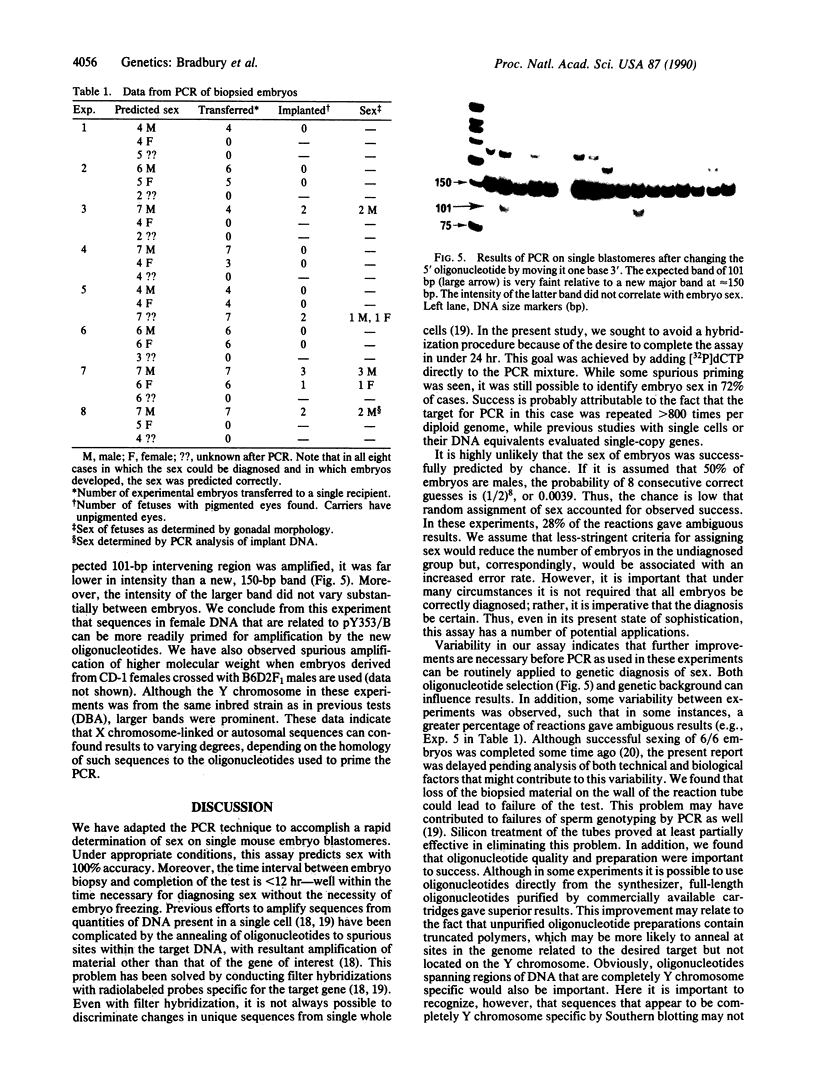
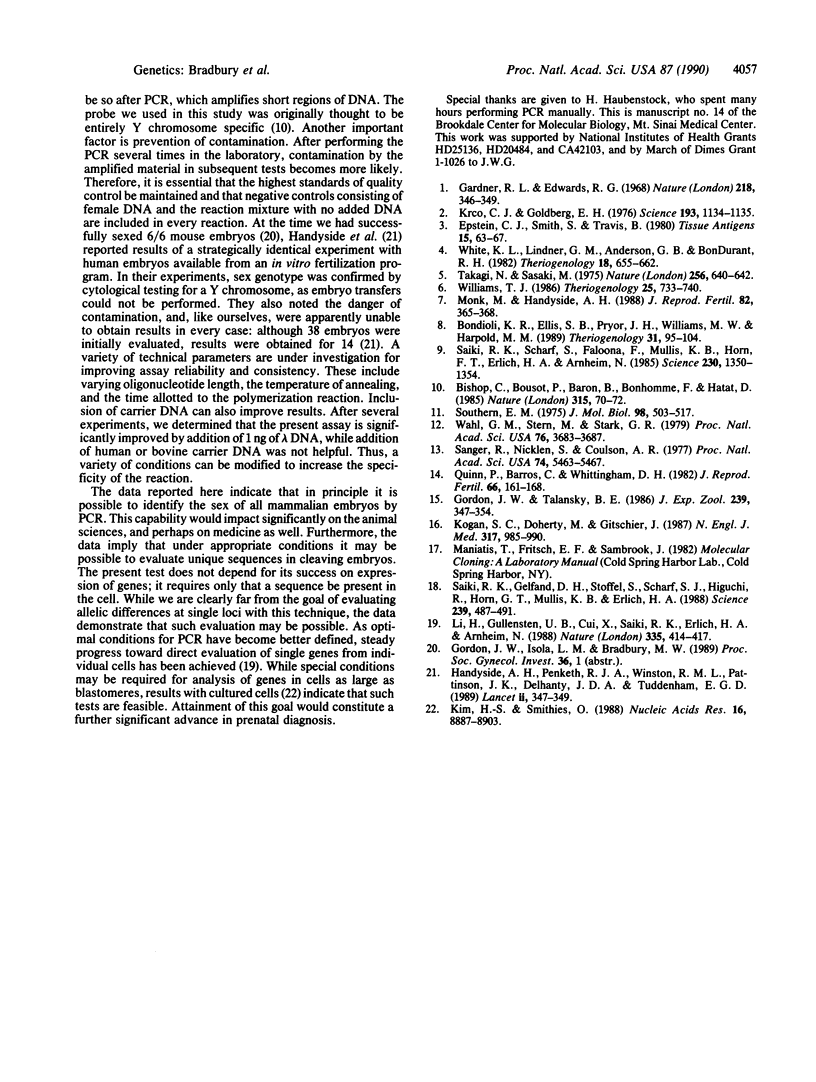
Images in this article
Selected References
These references are in PubMed. This may not be the complete list of references from this article.
- Bishop C. E., Boursot P., Baron B., Bonhomme F., Hatat D. Most classical Mus musculus domesticus laboratory mouse strains carry a Mus musculus musculus Y chromosome. Nature. 1985 May 2;315(6014):70–72. doi: 10.1038/315070a0. [DOI] [PubMed] [Google Scholar]
- Epstein C. J., Smith S., Travis B. Expression of H-Y antigen on preimplantation mouse embryos. Tissue Antigens. 1980 Jan;15(1):63–67. doi: 10.1111/j.1399-0039.1980.tb00886.x. [DOI] [PubMed] [Google Scholar]
- Gardner R. L., Edwards R. G. Control of the sex ratio at full term in the rabbit by transferring sexed blastocysts. Nature. 1968 Apr 27;218(5139):346–349. doi: 10.1038/218346a0. [DOI] [PubMed] [Google Scholar]
- Gordon J. W., Talansky B. E. Assisted fertilization by zona drilling: a mouse model for correction of oligospermia. J Exp Zool. 1986 Sep;239(3):347–354. doi: 10.1002/jez.1402390306. [DOI] [PubMed] [Google Scholar]
- Handyside A. H., Pattinson J. K., Penketh R. J., Delhanty J. D., Winston R. M., Tuddenham E. G. Biopsy of human preimplantation embryos and sexing by DNA amplification. Lancet. 1989 Feb 18;1(8634):347–349. doi: 10.1016/s0140-6736(89)91723-6. [DOI] [PubMed] [Google Scholar]
- Kim H. S., Smithies O. Recombinant fragment assay for gene targetting based on the polymerase chain reaction. Nucleic Acids Res. 1988 Sep 26;16(18):8887–8903. doi: 10.1093/nar/16.18.8887. [DOI] [PMC free article] [PubMed] [Google Scholar]
- Kogan S. C., Doherty M., Gitschier J. An improved method for prenatal diagnosis of genetic diseases by analysis of amplified DNA sequences. Application to hemophilia A. N Engl J Med. 1987 Oct 15;317(16):985–990. doi: 10.1056/NEJM198710153171603. [DOI] [PubMed] [Google Scholar]
- Krco C. J., Goldberg E. H. H-Y male antigen: detection on eight-cell mouse embryos. Science. 1976 Sep 17;193(4258):1134–1135. doi: 10.1126/science.959826. [DOI] [PubMed] [Google Scholar]
- Li H. H., Gyllensten U. B., Cui X. F., Saiki R. K., Erlich H. A., Arnheim N. Amplification and analysis of DNA sequences in single human sperm and diploid cells. Nature. 1988 Sep 29;335(6189):414–417. doi: 10.1038/335414a0. [DOI] [PubMed] [Google Scholar]
- Monk M., Handyside A. H. Sexing of preimplantation mouse embryos by measurement of X-linked gene dosage in a single blastomere. J Reprod Fertil. 1988 Jan;82(1):365–368. doi: 10.1530/jrf.0.0820365. [DOI] [PubMed] [Google Scholar]
- Quinn P., Barros C., Whittingham D. G. Preservation of hamster oocytes to assay the fertilizing capacity of human spermatozoa. J Reprod Fertil. 1982 Sep;66(1):161–168. doi: 10.1530/jrf.0.0660161. [DOI] [PubMed] [Google Scholar]
- Saiki R. K., Gelfand D. H., Stoffel S., Scharf S. J., Higuchi R., Horn G. T., Mullis K. B., Erlich H. A. Primer-directed enzymatic amplification of DNA with a thermostable DNA polymerase. Science. 1988 Jan 29;239(4839):487–491. doi: 10.1126/science.2448875. [DOI] [PubMed] [Google Scholar]
- Saiki R. K., Scharf S., Faloona F., Mullis K. B., Horn G. T., Erlich H. A., Arnheim N. Enzymatic amplification of beta-globin genomic sequences and restriction site analysis for diagnosis of sickle cell anemia. Science. 1985 Dec 20;230(4732):1350–1354. doi: 10.1126/science.2999980. [DOI] [PubMed] [Google Scholar]
- Sanger F., Nicklen S., Coulson A. R. DNA sequencing with chain-terminating inhibitors. Proc Natl Acad Sci U S A. 1977 Dec;74(12):5463–5467. doi: 10.1073/pnas.74.12.5463. [DOI] [PMC free article] [PubMed] [Google Scholar]
- Southern E. M. Detection of specific sequences among DNA fragments separated by gel electrophoresis. J Mol Biol. 1975 Nov 5;98(3):503–517. doi: 10.1016/s0022-2836(75)80083-0. [DOI] [PubMed] [Google Scholar]
- Takagi N., Sasaki M. Preferential inactivation of the paternally derived X chromosome in the extraembryonic membranes of the mouse. Nature. 1975 Aug 21;256(5519):640–642. doi: 10.1038/256640a0. [DOI] [PubMed] [Google Scholar]
- Wahl G. M., Stern M., Stark G. R. Efficient transfer of large DNA fragments from agarose gels to diazobenzyloxymethyl-paper and rapid hybridization by using dextran sulfate. Proc Natl Acad Sci U S A. 1979 Aug;76(8):3683–3687. doi: 10.1073/pnas.76.8.3683. [DOI] [PMC free article] [PubMed] [Google Scholar]
- Williams T. J. A technique for sexing mouse embryos by a visual colorimetric assay of the X-linked enzyme, glucose 6-phosphate dehydrogenase. Theriogenology. 1986 May;25(5):733–739. doi: 10.1016/0093-691x(86)90131-7. [DOI] [PubMed] [Google Scholar]






